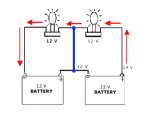PeeWeeQ
Member
- 161
- 4
- 18
- Location
- Altoona, WI
I'm starting to wonder what the *#!@ is going on...Thank goodness I have those battery cutoff switches installed...
Just to see if it just MIGHT solve my Gen 2 problem, I got an Autozone alternator to move into the gen 1 spot and moved gen 1 into the old (twice rebuilt) gen 2 spot. I left the grounds for gen 1 wrapped in electrical tape and zip-tied out of the way. I wired gen 2 (the old gen 1) EXACTLY the way I took the old gen 2 apart. When I rotated the cutoff switches to close the circuits, keeping my hands on them, I heard a small "pop" from the Gen 2 area, and immediately rotated them back open. OK. Double check wiring illustration from an old post in an old alternator thread from Warthog. Found that I had the solid red and red/white leads backwards. So, I switched the wires and moved the orange wire (fusible link) to the positive terminal as well. Should be good, right?
Rotated the switches to the closed position again, and, AGAIN, kept my hands on them, waited approximately 1.5 to 2 seconds, and, just when I thought it was going well, the smoke started rolling from the 12 volt block and I IMMEDIATELY rotated the switches open as my heart sank and blood pressure rose...
I'm at a loss. I checked all of the battery wires and grounds and traced their paths. Near as I can tell, it's all correct.
I'm sure I did something stupid, but, W-H-A-T ! ? ! What could cause this problem? I have not messed with any other wires other than the leads right at the alternator terminals and that of the batteries (which are correct). When I replaced all of the fusible links, I did them one at a time to avoid misrouting them...
Guess I'm gonna have to pull apart harnesses and wire loom to trace every single wire's path.
I just want to drive the dang thing and enjoy it! I'm really burnt out on this problem (so is my wife) and now I feel like I've gone 2 steps backward....
Sent from my SM-G920V using Tapatalk
Just to see if it just MIGHT solve my Gen 2 problem, I got an Autozone alternator to move into the gen 1 spot and moved gen 1 into the old (twice rebuilt) gen 2 spot. I left the grounds for gen 1 wrapped in electrical tape and zip-tied out of the way. I wired gen 2 (the old gen 1) EXACTLY the way I took the old gen 2 apart. When I rotated the cutoff switches to close the circuits, keeping my hands on them, I heard a small "pop" from the Gen 2 area, and immediately rotated them back open. OK. Double check wiring illustration from an old post in an old alternator thread from Warthog. Found that I had the solid red and red/white leads backwards. So, I switched the wires and moved the orange wire (fusible link) to the positive terminal as well. Should be good, right?
Rotated the switches to the closed position again, and, AGAIN, kept my hands on them, waited approximately 1.5 to 2 seconds, and, just when I thought it was going well, the smoke started rolling from the 12 volt block and I IMMEDIATELY rotated the switches open as my heart sank and blood pressure rose...
I'm at a loss. I checked all of the battery wires and grounds and traced their paths. Near as I can tell, it's all correct.
I'm sure I did something stupid, but, W-H-A-T ! ? ! What could cause this problem? I have not messed with any other wires other than the leads right at the alternator terminals and that of the batteries (which are correct). When I replaced all of the fusible links, I did them one at a time to avoid misrouting them...
Guess I'm gonna have to pull apart harnesses and wire loom to trace every single wire's path.
I just want to drive the dang thing and enjoy it! I'm really burnt out on this problem (so is my wife) and now I feel like I've gone 2 steps backward....
Sent from my SM-G920V using Tapatalk
Last edited:


![20160413_205524[1].jpg 20160413_205524[1].jpg](https://www.steelsoldiers.com/data/attachments/421/421511-131ff0a5e17ad946912497b097d74ed5.jpg)
![20160414_203520[1].jpg 20160414_203520[1].jpg](https://www.steelsoldiers.com/data/attachments/421/421564-b320f348e09fc8230bc15d9a4c211a4a.jpg)
![20160414_214644[1].jpg 20160414_214644[1].jpg](https://www.steelsoldiers.com/data/attachments/421/421565-2bd143f6d14f184715cd8dacae81bb49.jpg)

